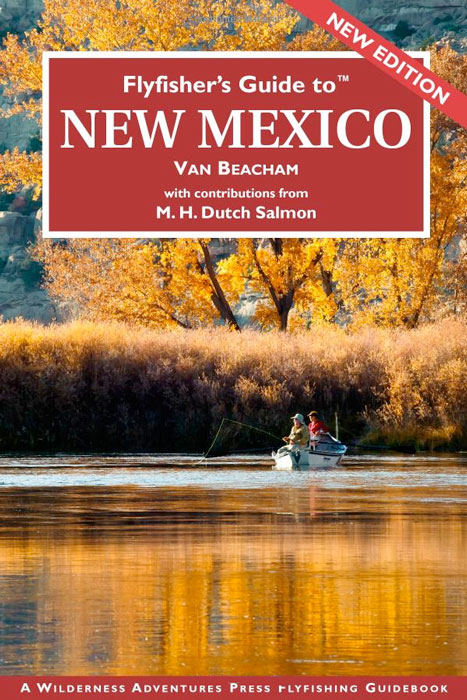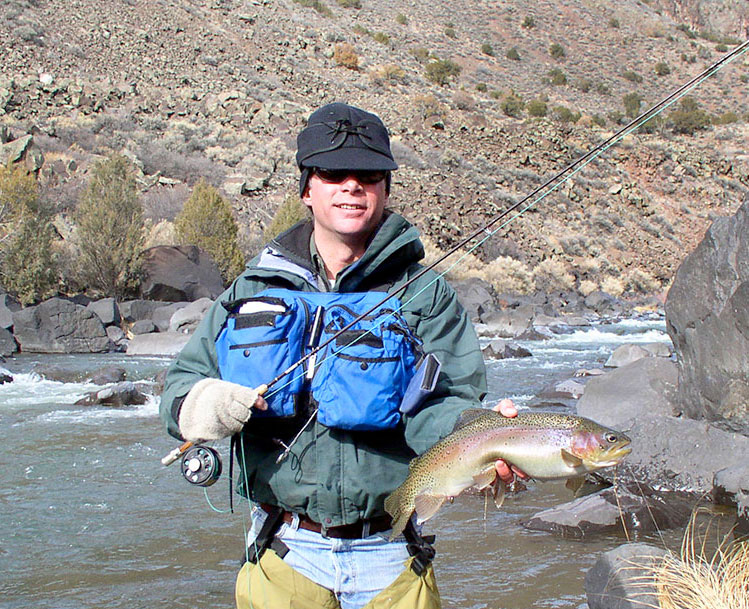(excerpted from the Flyfisher’s Guide to™ New Mexico by Van Beacham) –

Most people think of the Rio Grande as a muddy channel along the Mexican border, but like many great American rivers, the Rio Grande originates high in the Rocky Mountains. Two tremendous mountain ranges, the San Juans and the Sangre de Cristos, are the source of hundreds of crystal-clear creeks, streams, and lakes in northern New Mexico and southern Colorado, all of which are part of the Rio Grande watershed. After gathering these headwaters, the Rio Grande flows through the broad San Luis Valley and enters the Rio Grande Gorge 14 miles north of the New Mexico state line.
Known locally as the Gorge, it was not actually carved by the big river. Rather, the river followed a pre-established and partly filled rift valley. The rift continues to widen today, and ongoing geological activity is evident through heat flow, hot springs, geodesic observations, and some of North America’s most recent lava flows.
The Gorge runs parallel to, and slightly west of, the Sangre de Cristo Mountains, splitting northern New Mexico in half. It’s over 90 miles long, and four tributaries provide an additional 18 miles of great fishing. The Rio Grande is a challenging river, and anglers should be physically fit before descending into the depths of the mighty Gorge. But it’s just the place for anglers who appreciate the finer aspects of flyfishing, such as limitless solitude, magnificent scenery, and a chance to catch large wild trout year-round.

Congress passed the Wild and Scenic Rivers Act in 1968, and the Rio Grande and the lower Red River were the first rivers to be so designated. Although guaranteed to be free flowing and free of pollution, the Rio Grande Gorge and Red River have been marred by mining and farming pollution, and the Rio Grande has dropped below 10 cfs at the Colorado border at least once since the Wild and Scenic designation. Nevertheless, it remains one of the nation’s most pristine and important wild trout fisheries.
The “great river” has been under constant change since its beginning, and that evolution continues today. Like many western rivers, the future of the Gorge as a trout fishery remains uncertain because urban and agricultural interests continue to increase their demands for water and climate change continues to threaten trout fisheries in general by raising water temperatures.
Until recently, there was no real scientific data on the number or average size of fish in the Gorge, although anglers who fish the river regularly know that populations are healthy and increasing steadily. In 1993 there were several browns over 8 pounds caught, mostly by baitfishermen. And in February 1994 a 14½-pound cuttbow was caught in the Red River. In 2008, an actual electro shocking survey was done in the Taos Box section of the Gorge that revealed a healthy trout fishery, despite the previous seven-year drought.
Several factors have contributed to the comeback of the Gorge and the lower Red River as fisheries. New water agreements with Colorado, improved farming and irrigation techniques, the elimination of potentially dangerous fertilizers and pesticides, above normal runoff for two decades, mine rehabilitation and closures at several locations, and overall enhancement of the riparian zone and range land within the watershed have all helped the ongoing rehabilitation of the Gorge.
The resurgence has been amazing, with great hatches and spawning runs on both the Red River and the Rio Grande until 2008 when a tremendous flash flood occurred in the upper Red River Canyon. The flood caused the ground at and near the Molybdenum mine to become severely unstable resulting in a gigantic mudslide. It killed virtually everything in the Red River below the slide and significantly impacted the Rio Grande for several miles below the Red River.
Since then, the lower Red River has been struggling to survive and brown and cutbow trout runs have been bleak at best. Stocking of rainbows has helped and there are many small, wild browns present that will eventually replenish this resilient stretch of the Red River. The Rio Grande itself seems to have survived the disaster. It seems as though the fate of the Red River, and to some extent, the lower Rio Grande, is in the hands of the mine and the government. As the mine and the area around it goes, so goes the Red River; let’s hope they fix it!
The river’s current status proves that when commercial and private users work together with government agencies they can make a difference. Dewatering still remains a major threat, however, and it will require even more effort by everyone involved to avoid a major catastrophe in the future. Huge piles of tailings at the Molycorp Mine, located on the edge of the Red River, have been determined to be unstable, and it’s now a question of when, not if, they end up in the Red River and, ultimately, the Rio Grande. Something needs to be done before it’s too late for both rivers.
Unfortunately, global warming poses a new threat to the Gorge and all southwestern trout fisheries. In 1997, 2000, 2002, and again in 2003 the middle valley sections of some of the tributaries of the Gorge were drastically dewatered, and some dried up for the first time in recorded history. Where flows remained, the water temperatures soared to a whopping 87 degrees, killing all fish in those sections.
The Rio Grande also reached temperatures above 80 degrees during the drought, and the flow in the spring of 2003 was the lowest ever recorded. Because of these impacts, the northern pike and smallmouth bass population in the Gorge is increasing, and pressure is mounting on government agencies to change its current cold-water designation to a warmwater fishery. From 2005 through 2009, our snow pack in the Rio Grande Basin was considerably above normal and our temperatures around normal resulting in improved fishing throughout the region.
The Gorge is rugged, with rocky and steep terrain, and most access is limited to a few well-developed trails, a dozen or so primitive trails, and just two areas of roadside access. Anglers should be ready to hike in the Gorge, which ranges from 200 to 1,200 feet in depth. A typical trip into the Gorge and back out entails a walk of ½ to 3 miles. Potential hazards include thunderstorms, snowstorms, falling rock, rattlesnakes, dehydration, and uncertain footing.
Hip waders or breathable pant waders with lug soles are ideal for hiking the Gorge, boulder hopping along the riverbanks, and wading the silty river bottom near shore. Breathable chest waders are advisable for aggressive waders, except in the NRA (national recreation area) section, where wading above your knees can be dangerous. Many anglers prefer to wet wade when it’s hot.
Winter can be especially dangerous since snow and ice add to the already difficult terrain. Do not wear felt soles in the Gorge as they are of no use on clay and rock trails, slick, giant boulders in and around the river, ice and snow, which sticks to the felt soles, and steep unstable banks. This lesson was beat into my head on a winter trip into the Gorge in late January 2009.
I was guiding Brandon Mathews and his friend, Bill on a trip to the confluence of the Red River and the Rio Grande. Both anglers were wearing felt soles and it had snowed about an inch or two the night before and many of the boulders were covered with snow and ice. I emphasized to them the dangers, especially having felt soles, and I was instinctively wary from the moment I woke up that morning; almost sensing an impending dangerous situation.
It was a great day, having caught and lost several nice trout before breaking for lunch. They were chomping at the bit to get back to fishing so I checked their rigs and prompted them down the steep, icy trail to the bank of the Red River while I proceeded to pack up after lunch. They were just a few yards away from me for no more than a minute when I heard Brandon yell, “Help! Help!” I knew it wasn’t “help, I hooked a fish.” It was “help, I’m in danger!”
I dropped everything and scrambled down to where he was and found him soaked from head to toe, sitting on a rock, definitely cold and appearing to go into shock. I said “Okay, you’re totally soaked but is there anything else wrong?” He nodded his head and said, “I think I broke my ankle; I heard something snap.” I looked around and saw his rod in the water so I picked it up and upon inspection, replied, “Well it wasn’t your rod.
I calmed him down and coaxed him to let me help him get up and out of the river and up the hill to the shelter where we had lunch. From here I could get him out of his wet clothes and give him a layer of my dry clothes. Sure enough he had slipped on a big rock and his ankle was broken. And it was 2:00pm in the middle of winter and 1.5 miles straight up to the top, where our cars were parked. Not a good situation to be sure!
After suiting him back up and giving hip several ibuprofen caplets to control the pain and swelling, I tightened his rigid boot around his broken ankle to act as a splint and told him he had a decision to make. Either try to hobble out with some canes and our assistance or wait here with his friend while I get help, in which case he might have to stay down there overnight. It took him one second to say, “I’m walkin’ outta’ here, I’m not staying down here!” With that I found him a couple of walking sticks and he took off. Meanwhile, Bill was still focused on getting a few more casts in and was already a quarter mile upstream. He looked at me and pointed up to the rim, suggesting that he would meet us at the trail. I thought to myself, “oh my god, that’s all I need now is for Bill to fall trying to scramble up the side of the canyon”. He didn’t, thankfully.
Normally, it takes about 45 minutes to get out but it only took Brandon about an hour and a half and he never complained or groaned, save one time when he had to step up a 3-foot boulder. It turned out he had two spiral fractures on his ankle. The lessons: Don’t wear felt soles and don’t try walking on slick, angled rocks near the shore with wet or felt soles!
Each of the river’s tributaries adds its own unique qualities to the Gorge. These streams originate high in the Sangre de Cristo Mountains and enhance the water quality of the Rio Grande. Fish regularly migrate between the Rio Grande and the tributaries to spawn, feed, and, in some cases, winter over.
The Gorge and its tributaries represent an immense fishery with varying conditions, and the fish are as temperamental as the river itself. The Rio Grande is a freestone river, and a major rainstorm anywhere in the watershed can make the river murky. Water temperatures drop to 38 degrees in the winter and soar to 70 degrees (sometimes higher) in midsummer. I’ve seen it go from 40 degrees in the morning to 58 degrees by midafternoon.
All of this can make the Gorge difficult to understand, and for anglers new to the area it can be intimidating. You must meet the Gorge on its own terms and realize that the trout generally feed only when conditions are right. Of course, knowing the optimal times, places, fly patterns, and techniques can greatly increase your chance for success.
During spring, before runoff, and in drought years, the spring Baetis and caddis hatches provide a great opportunity to catch some really big browns, and occasionally fat cuttbows, on dries. During the last drought, the spring fishing was exceptional, the best I’ve seen since I first fished here in 1964. Various caddis hatches occur throughout summer, and large Golden Stones, Brown Drakes, Pale Morning Duns, and craneflies hatch in June and July. Chubs, minnows, and crayfish are also abundant in the Gorge, providing nourishment for the large browns, ’bows, and northern pike.
A tremendous moth hatch takes place in June and July, providing some great
fishing opportunities in the evening and at night. My father and I used to fish at night during these hatches, taking many big browns. After not seeing a rise all day, I’d suddenly hear huge fish thrashing the surface for moths and craneflies.
The Gorge has virtually every type of water, from broad riffles and pools to deep holes and long flats, but the one word that best describes the Gorge is “pockets.” The entire Gorge is composed of volcanic basalt, and basalt boulders are strewn throughout the river bottom. This provides maximum cover and holding water, and you never know for sure which pockets are holding fish at a given time.
Except during peak runoff, the Gorge or one of its tributaries is always fishable, making this a true year-round fishery. The best times to fish here are just before and after runoff, early morning and late evening during the summer, all day in the fall, and from about 1:00 p.m. until dark in the winter, except on the lower Red River, where winter fishing is good all day long.
The Gorge also has a significant smallmouth bass population that provides good angling opportunities during the midday heat of summer. Northern pike are present too, especially in Ute Mountain Run and the Lower Box section near Pilar. It’s possible to land some very big northerns in winter, spring, summer and fall (see Rio Grande Pike section at the end of this chapter).
From where the Gorge begins in southern Colorado to where it ends near Velarde, New Mexico, the Rio Grande fishery has five distinct sections. From north to south, these are: The Ute Mountain Run, the Wild and Scenic Recreation Area, the Middle Box, the Taos Box, and the Lower Box.


